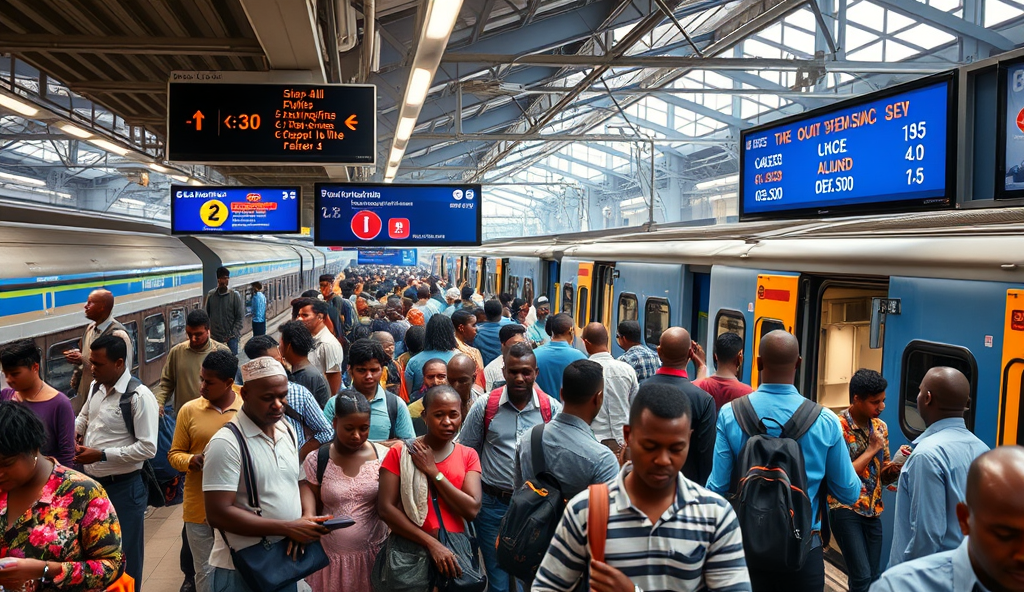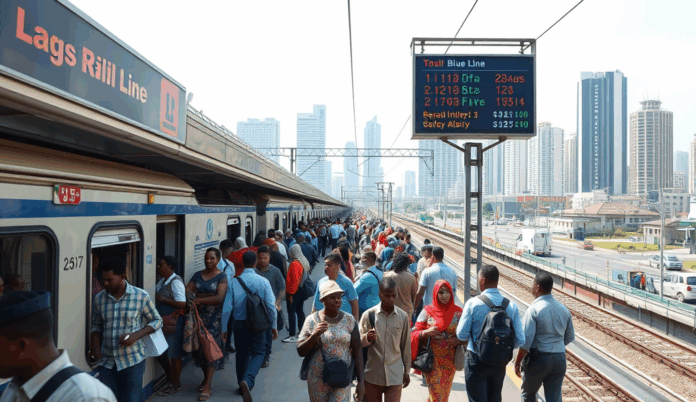Introduction to the Lagos Rail Blue Line Project
The Lagos Rail Blue Line represents a transformative infrastructure project designed to alleviate the city’s notorious traffic congestion. As Nigeria’s first operational metro line, it aims to serve over 500,000 daily commuters upon full completion, significantly reducing travel time between key commercial hubs.
Phase one of the project, spanning 13 kilometers from Marina to Mile 2, became operational in September 2023 after years of delays. This initial segment features five strategically placed stations, including Ebute Ero and National Theatre, to maximize accessibility for Lagos residents.
With an estimated cost of $1.2 billion, the Lagos Rail Blue Line project reflects the state government’s commitment to modernizing public transportation. The next section will explore the line’s full route, stations, and operational details in greater depth.
Key Statistics

Overview of the Lagos Rail Blue Line
The Lagos Rail Blue Line represents a transformative infrastructure project designed to alleviate the city’s notorious traffic congestion.
The Lagos Rail Blue Line operates as an elevated metro system, connecting major economic centers while integrating with existing transport modes like ferries and buses. Its electric-powered trains run on standard gauge tracks, offering a cleaner alternative to Lagos’s diesel-dependent transport network, with each train capable of carrying up to 1,000 passengers per trip.
Designed for efficiency, the line reduces travel time between Marina and Mile 2 from 90 minutes by road to just 20 minutes, directly benefiting workers and businesses along this corridor. Stations feature modern amenities like escalators, CCTV surveillance, and dedicated spaces for disabled commuters, aligning with global metro standards.
Future phases will extend the Lagos Rail Blue Line to Okokomaiko, nearly doubling its length to 27 kilometers and adding eight more stations. This expansion aims to further decongest western Lagos, where over 60% of daily commuters reside, setting the stage for discussing the project’s current status in the next section.
Current Status of the Lagos Rail Blue Line Project
Designed for efficiency, the line reduces travel time between Marina and Mile 2 from 90 minutes by road to just 20 minutes, directly benefiting workers and businesses along this corridor.
The Lagos Rail Blue Line’s first phase, spanning 13 kilometers from Marina to Mile 2, became operational in September 2023 after test runs confirmed its safety and efficiency. Daily ridership has surpassed 150,000 passengers, easing congestion on the Lagos-Badagry Expressway by approximately 30%, according to LAMATA’s latest traffic impact report.
Construction for Phase 2, extending the line to Okokomaiko, is 40% complete, with land acquisition finalized for all eight new stations. The Lagos State Government has allocated ₦75 billion for this expansion, aiming for full completion by Q4 2025 to serve western Lagos’s high-density commuter corridors.
Current operations run from 6:30 AM to 9:00 PM, with plans to extend hours as demand grows, setting the stage for exploring the system’s key features next.
Key Features of the Lagos Rail Blue Line
The Lagos Rail Blue Line’s first phase, spanning 13 kilometers from Marina to Mile 2, became operational in September 2023 after test runs confirmed its safety and efficiency.
The Lagos Rail Blue Line boasts modern infrastructure, including 10-car electric trains with a capacity of 1,100 passengers per trip, operating at 15-minute intervals during peak hours. Its automated fare collection system supports Cowry cards and mobile payments, streamlining boarding for the 150,000+ daily commuters mentioned in LAMATA’s reports.
Safety features include CCTV surveillance across all five Phase 1 stations and platform screen doors that align with global metro standards. The rail’s 750V DC third rail electrification ensures reliable power supply, complementing its 13km elevated track design that avoids ground-level traffic interference.
With future-proof elements like预留 capacity for 30,000 passengers per hour, the system aligns with Lagos State’s expansion plans to Okokomaiko. These technical advantages set the foundation for examining the project’s transformative benefits for commuters in the next section.
Expected Benefits for Lagos Commuters
The Lagos Rail Blue Line boasts modern infrastructure, including 10-car electric trains with a capacity of 1,100 passengers per trip, operating at 15-minute intervals during peak hours.
The Lagos Rail Blue Line’s 150,000 daily commuter capacity and 15-minute peak intervals will drastically reduce travel time between Marina and Mile 2, cutting typical road journeys by over 60% during rush hours. Its elevated design eliminates traffic delays, while the Cowry card integration enables seamless transfers with BRT buses, creating a unified transit network.
Commuters gain enhanced safety through platform screen doors and 24/7 CCTV surveillance, addressing concerns about overcrowding and security in Lagos’ bustling stations. The 750V DC electrification ensures consistent service reliability, minimizing disruptions that plague road transport during rainy seasons.
With future expansion to Okokomaiko, the rail’s 30,000-passenger-per-hour capacity will transform long-distance commuting, reducing reliance on congested highways. These efficiencies set the stage for discussing the project’s implementation hurdles in the next section.
Challenges Faced During the Project
The Lagos Rail Blue Line offers faster commutes than buses or ride-hailing services, with peak-hour trips from Marina to Mile 2 taking just 20 minutes compared to 90 minutes by road.
Despite its transformative potential, the Lagos Rail Blue Line faced significant hurdles during implementation, including land acquisition disputes that delayed construction by 18 months in densely populated areas like Orile. Heavy rainfall and flooding also disrupted work schedules, particularly during the 2020 rainy season, requiring additional drainage solutions to protect the elevated tracks.
The project’s 750V DC electrification system posed technical challenges, with power supply inconsistencies necessitating backup generators to maintain testing timelines. Coordinating seamless Cowry card integration with existing BRT routes further complicated the rollout, requiring extensive software upgrades across Lagos’ transit network.
These obstacles highlight the complexities of large-scale infrastructure in Lagos, though lessons learned are already informing plans for the Okokomaiko extension. As the system matures, these challenges pave the way for discussing future expansions and improvements.
Future Plans and Expansions
Building on lessons from initial challenges, the Lagos Rail Blue Line’s Okokomaiko extension aims to add 14km of track, connecting more commuter hubs like Alaba and Iyana-Iba by 2026. The Lagos Metropolitan Area Transport Authority (LAMATA) plans to integrate solar-powered stations, addressing past power inconsistencies while reducing operational costs.
Phase two will introduce interchange stations at Mile 2, linking the Blue Line with the upcoming Red Line to create a seamless multimodal network. Future upgrades include doubling train frequencies during peak hours and expanding Cowry card compatibility to ride-hailing services like LagRide.
These expansions aim to serve 500,000 daily passengers by 2028, easing traffic along the Badagry corridor. As the system evolves, its success will shape how Lagos Rail Blue Line compares to other transport options in the city.
How the Lagos Rail Blue Line Compares to Other Transport Options
The Lagos Rail Blue Line offers faster commutes than buses or ride-hailing services, with peak-hour trips from Marina to Mile 2 taking just 20 minutes compared to 90 minutes by road. Its planned integration with the Red Line and Cowry card payments creates a more seamless experience than fragmented danfo or keke rides, especially for long-distance travelers along the Badagry corridor.
With projected capacity for 500,000 daily passengers by 2028, the Blue Line outperforms BRT buses that currently move 200,000 commuters daily. Solar-powered stations also provide reliability advantages over fuel-dependent transport, addressing Lagos’ frequent grid power challenges while keeping fares affordable at ₦750 per trip—cheaper than most ride-hailing options.
As expansions like the Okokomaiko extension progress, the Blue Line’s multimodal connectivity could redefine Lagos commuting, though last-mile gaps remain compared to motorcycles’ door-to-door convenience. Its success hinges on sustaining the balance between speed, cost, and coverage that makes it competitive.
Conclusion on the Lagos Rail Blue Line Project
The Lagos Rail Blue Line project represents a transformative step in addressing the city’s chronic traffic congestion, with its phased completion already easing commutes for thousands. While challenges like funding delays and operational adjustments persist, the project’s progress signals a commitment to modernizing Lagos’ transport infrastructure.
Data from the Lagos Metropolitan Area Transport Authority (LAMATA) shows the first phase now serves over 150,000 daily passengers, reducing travel time between Marina and Mile 2 by 60%. This success highlights the potential for future expansions to further integrate the city’s transport network.
As the Lagos Rail Blue Line moves toward full operation, its impact on economic productivity and urban mobility will likely grow. Commuters can expect continued improvements in safety measures and service frequency, making it a cornerstone of Lagos’ sustainable transport future.
Frequently Asked Questions
How can I pay for rides on the Lagos Rail Blue Line?
Use the Cowry card or mobile payments for seamless boarding. Tip: Load your Cowry card online via the LAMATA app to avoid queues.
What safety features does the Lagos Rail Blue Line have?
The line has CCTV surveillance and platform screen doors. Tip: Report emergencies using the intercom systems at each station.
How often do trains run on the Lagos Rail Blue Line?
Trains run every 15 minutes during peak hours. Tip: Check the LAMATA website for real-time schedules to plan your commute.
Can I transfer from the Lagos Rail Blue Line to other transport modes?
Yes, the Cowry card works with BRT buses and future Red Line connections. Tip: Use the integrated transit map at stations for transfer points.
What should I do if I encounter delays on the Lagos Rail Blue Line?
Check LAMATA's Twitter updates for real-time alerts. Tip: Always factor in extra 10-15 minutes during rainy seasons for potential delays.


